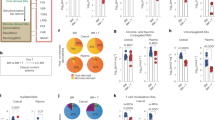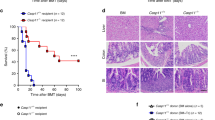Abstract
Graft versus host disease (GvHD), which is the primary complication of allogeneic bone marrow transplantation, can alter the intestinal barrier targeted by activated donor T-cells. Chemical inhibition of the stress protein HSP90 was demonstrated in vitro to inhibit T-cell activation and to modulate endoplasmic reticulum (ER) stress to which intestinal cells are highly susceptible. Since the HSP90 inhibitor 17-allylamino-demethoxygeldanamycin (17AAG) is developed in clinics, we explored here its ability to control intestinal acute GvHD in vivo in two mouse GvHD models (C57BL/6→BALB/c and FVB/N→Lgr5-eGFP), ex vivo in intestine organoids and in vitro in intestinal epithelial cultures. We show that 17AAG decreases GvHD-associated mortality without impairing graft versus leukemia effect. While 17AAG effect in T-cell activation is just moderate at the dose used in vivo, we observe a striking intestinal integrity protection. At the intestine level, the drug promotes the splicing of the transcription factor X-box binding protein 1 (XBP1), which is a key component of the ER stress. This effect is associated with a decrease in intestinal damage and an increase in Lgr5+ stem cells, Paneth cells and defensins production. The importance of XBP1 splicing control is further confirmed in cultured cells and organoids of primary intestinal epithelium where XBP1 is either shRNA depleted or inhibited with toyocamycin. In conclusion, 17AAG has a protective effect on the epithelial intestinal barrier in mouse models of acute GvHD. This compound deserves to be tested in the therapeutic control of acute GvHD.
This is a preview of subscription content, access via your institution
Access options
Subscribe to this journal
Receive 50 print issues and online access
$259.00 per year
only $5.18 per issue
Buy this article
- Purchase on Springer Link
- Instant access to full article PDF
Prices may be subject to local taxes which are calculated during checkout






Similar content being viewed by others
Change history
02 June 2016
This article has been corrected since Advance Online Publication and a corrigendum is also printed in this issue
Abbreviations
- 17AAG:
-
17-allylamino-demethoxygeldanamycin
- ER:
-
endoplasmic reticulum
- GvHD:
-
graft versus host disease
- GvL:
-
graft versus leukemia
- HSP:
-
heat shock protein
- IEC:
-
intestinal epithelial cell
- ISC:
-
intestinal stem cell
- UPR:
-
unfolded protein response
- XBP1:
-
X-box binding protein 1
References
Ferrara JL, Levine JE, Reddy P, Holler E . Graft-versus-host disease. Lancet 2009; 373: 1550–1561.
Stuehler C, Mielke S, Chatterjee M, Duell J, Lurati S, Rueckert F et al. Selective depletion of alloreactive T cells by targeted therapy of heat shock protein 90: a novel strategy for control of graft-versus-host disease. Blood 2009; 114: 2829–2836.
Marcu MG, Doyle M, Bertolotti A, Ron D, Hendershot L, Neckers L . Heat shock protein 90 modulates the unfolded protein response by stabilizing IRE1alpha. Mol Cell Biol 2002; 22: 8506–8513.
Davenport EL, Moore HE, Dunlop AS, Sharp SY, Workman P, Morgan GJ et al. Heat shock protein inhibition is associated with activation of the unfolded protein response pathway in myeloma plasma cells. Blood 2007; 110: 2641–2649.
Mimura N, Fulciniti M, Gorgun G, Tai YT, Cirstea D, Santo L et al. Blockade of XBP1 splicing by inhibition of IRE1alpha is a promising therapeutic option in multiple myeloma. Blood 2012; 119: 5772–5781.
Cooke KR, Hill GR, Crawford JM, Bungard D, Brinson YS, Delmonte J Jr . et al. Tumor necrosis factor-alpha production to lipopolysaccharide stimulation by donor cells predicts the severity of experimental acute graft-versus-host disease. J Clin Invest 1998; 102: 1882–1891.
Hill GR, Ferrara JL . The primacy of the gastrointestinal tract as a target organ of acute graft-versus-host disease: rationale for the use of cytokine shields in allogeneic bone marrow transplantation. Blood 2000; 95: 2754–2759.
Murphy S, Nguyen VH . Role of gut microbiota in graft-versus-host disease. Leuk Lymphoma 2011; 52: 1844–1856.
Penack O, Holler E, van den Brink MR . Graft-versus-host disease: regulation by microbe-associated molecules and innate immune receptors. Blood 2010; 115: 1865–1872.
Eriguchi Y, Takashima S, Oka H, Shimoji S, Nakamura K, Uryu H et al. Graft-versus-host disease disrupts intestinal microbial ecology by inhibiting Paneth cell production of alpha-defensins. Blood 2012; 120: 223–231.
Sato T, van Es JH, Snippert HJ, Stange DE, Vries RG, van den Born M et al. Paneth cells constitute the niche for Lgr5 stem cells in intestinal crypts. Nature 2011; 469: 415–418.
Levine JE, Huber E, Hammer ST, Harris AC, Greenson JK, Braun TM et al. Low Paneth cell numbers at onset of gastrointestinal graft-versus-host disease identify patients at high risk for nonrelapse mortality. Blood 2013; 122: 1505–1509.
Kaser A, Martinez-Naves E, Blumberg RS . Endoplasmic reticulum stress: implications for inflammatory bowel disease pathogenesis. Curr Opin Gastroenterol 2010; 26: 318–326.
Kaser A, Lee AH, Franke A, Glickman JN, Zeissig S, Tilg H et al. XBP1 links ER stress to intestinal inflammation and confers genetic risk for human inflammatory bowel disease. Cell 2008; 134: 743–756.
Jego G, Hazoume A, Seigneuric R, Garrido C . Targeting heat shock proteins in cancer. Cancer Lett 2013; 332: 275–285.
Neckers L, Workman P . Hsp90 molecular chaperone inhibitors: are we there yet? Clin Cancer Res 2012; 18: 64–76.
Sato T, Clevers H . Growing self-organizing mini-guts from a single intestinal stem cell: mechanism and applications. Science 2013; 340: 1190–1194.
Contassot E, Murphy W, Angonin R, Pavy JJ, Bittencourt MC, Robinet E et al. In vivo alloreactive potential of ex vivo-expanded primary T lymphocytes. Transplantation 1998; 65: 1365–1370.
Couturier M, Lamarthee B, Arbez J, Renauld JC, Bossard C, Malard F et al. IL-22 deficiency in donor T cells attenuates murine acute graft-versus-host disease mortality while sparing the graft-versus-leukemia effect. Leukemia 2013; 27: 1527–1537.
Mjahed H, Girodon F, Fontenay M, Garrido C . Heat shock proteins in hematopoietic malignancies. Exp Cell Res 2012; 318: 1946–1958.
Didelot C, Lanneau D, Brunet M, Bouchot A, Cartier J, Jacquel A et al. Interaction of heat-shock protein 90 beta isoform (HSP90 beta) with cellular inhibitor of apoptosis 1 (c-IAP1) is required for cell differentiation. Cell Death Differ 2008; 15: 859–866.
Elo MA, Kaarniranta K, Helminen HJ, Lammi MJ . Hsp90 inhibitor geldanamycin increases hsp70 mRNA stabilisation but fails to activate HSF1 in cells exposed to hydrostatic pressure. Biochim Biophys Acta 2005; 1743: 115–119.
Tirosh B, Iwakoshi NN, Glimcher LH, Ploegh HL . Rapid turnover of unspliced Xbp-1 as a factor that modulates the unfolded protein response. J Biol Chem 2006; 281: 5852–5860.
Bertolotti A, Wang X, Novoa I, Jungreis R, Schlessinger K, Cho JH et al. Increased sensitivity to dextran sodium sulfate colitis in IRE1beta-deficient mice. J Clin Invest 2001; 107: 585–593.
Ri M, Tashiro E, Oikawa D, Shinjo S, Tokuda M, Yokouchi Y et al. Identification of Toyocamycin, an agent cytotoxic for multiple myeloma cells, as a potent inhibitor of ER stress-induced XBP1 mRNA splicing. Blood Cancer J 2012; 2: e79.
Moser C, Lang SA, Stoeltzing O . Heat-shock protein 90 (Hsp90) as a molecular target for therapy of gastrointestinal cancer. Anticancer Res 2009; 29: 2031–2042.
Pelicano H, Carew JS, McQueen TJ, Andreeff M, Plunkett W, Keating MJ et al. Targeting Hsp90 by 17-AAG in leukemia cells: mechanisms for synergistic and antagonistic drug combinations with arsenic trioxide and Ara-C. Leukemia 2006; 20: 610–619.
Biamonte MA, Van de Water R, Arndt JW, Scannevin RH, Perret D, Lee WC . Heat shock protein 90: inhibitors in clinical trials. J Med Chem 2010; 53: 3–17.
Bradley E, Zhao X, Wang R, Brann D, Bieberich E, Wang G . Low dose Hsp90 inhibitor 17AAG protects neural progenitor cells from ischemia induced death. J Cell Commun Signal 2014; 8: 353–362.
Wang G, Krishnamurthy K, Tangpisuthipongsa D . Protection of murine neural progenitor cells by the Hsp90 inhibitor 17-allylamino-17-demethoxygeldanamycin in the low nanomolar concentration range. J Neurochem 2011; 117: 703–711.
Salzman NH, Hung K, Haribhai D, Chu H, Karlsson-Sjoberg J, Amir E et al. Enteric defensins are essential regulators of intestinal microbial ecology. Nat Immunol 2010; 11: 76–83.
Kabiri Z, Greicius G, Madan B, Biechele S, Zhong Z, Zaribafzadeh H et al. Stroma provides an intestinal stem cell niche in the absence of epithelial Wnts. Development 2014; 141: 2206–2215.
Takashima S, Kadowaki M, Aoyama K, Koyama M, Oshima T, Tomizuka K et al. The Wnt agonist R-spondin1 regulates systemic graft-versus-host disease by protecting intestinal stem cells. J Exp Med 2011; 208: 285–294.
Hanash AM, Dudakov JA, Hua G, O'Connor MH, Young LF, Singer NV et al. Interleukin-22 protects intestinal stem cells from immune-mediated tissue damage and regulates sensitivity to graft versus host disease. Immunity 2012; 37: 339–350.
Choi SW, Reddy P . Current and emerging strategies for the prevention of graft-versus-host disease. Nat Rev Clin Oncol 2014; 11: 536–547.
Collins CB, Aherne CM, Yeckes A, Pound K, Eltzschig HK, Jedlicka P et al. Inhibition of N-terminal ATPase on HSP90 attenuates colitis through enhanced Treg function. Mucosal Immunol 2013; 6: 960–971.
Cooke KR, Kobzik L, Martin TR, Brewer J, Delmonte J Jr ., Crawford JM et al. An experimental model of idiopathic pneumonia syndrome after bone marrow transplantation: I. The roles of minor H antigens and endotoxin. Blood 1996; 88: 3230–3239.
Li XC, Jevnikar AM, Grant DR . Expression of functional ICAM-1 and VCAM-1 adhesion molecules by an immortalized epithelial cell clone derived from the small intestine. Cell Immunol 1997; 175: 58–66.
Werner T, Wagner SJ, Martinez I, Walter J, Chang JS, Clavel T et al. Depletion of luminal iron alters the gut microbiota and prevents Crohn's disease-like ileitis. Gut 2011; 60: 325–333.
Sato T, Vries RG, Snippert HJ, van de Wetering M, Barker N, Stange DE et al. Single Lgr5 stem cells build crypt-villus structures in vitro without a mesenchymal niche. Nature 2009; 459: 262–265.
Aucagne R, Droin N, Paggetti J, Lagrange B, Largeot A, Hammann A et al. Transcription intermediary factor 1 gamma is a tumor suppressor in mouse and human chronic myelomonocytic leukemia. J Clin Invest 2011; 121: 2361–2370.
Rerole AL, Gobbo J, De Thonel A, Schmitt E, Pais de Barros JP, Hammann A et al. Peptides and aptamers targeting HSP70: a novel approach for anticancer chemotherapy. Cancer Res 2011; 71: 484–495.
Cawley K, Deegan S, Samali A, Gupta S . Assays for detecting the unfolded protein response. Methods Enzymol 2011; 490: 31–51.
Acknowledgements
We thank J Haiech (University of Strasbourg), P Saas and B Gaugler (INSERM U1098, Besançon, France), for helpful discussions. We thank P Saas, H Clevers (Hubrecht Institute, The Netherlands) and A Jevnikar (Ontario, CA) for providing A20-luc cells, Lgr5-eGFP mice and IEC 4-1, respectively, and A Bouchot and JF Merlin (INSERM U866, Dijon, France) for excellent technical assistance. This work was supported by grants from the Institut National du Cancer, Agence Nationale de la Recherche, Ligue Nationale Contre le Cancer (‘Labeled teams’ to CG and ES), the Association pour la Recherche sur le Cancer (labeled team to CG and OD), and FEDER. CG team belongs to the LabEx LipSTIC and GR-Ex. ALJ has a doctoral fellowship from La Ligue Nationale Contre le Cancer and AD by the ‘Conseil Régional de Bourgogne’.
Author information
Authors and Affiliations
Corresponding author
Ethics declarations
Competing interests
The authors declare no conflict of interest.
Additional information
Supplementary Information accompanies this paper on the Oncogene website
Rights and permissions
About this article
Cite this article
Joly, AL., Deepti, A., Seignez, A. et al. The HSP90 inhibitor, 17AAG, protects the intestinal stem cell niche and inhibits graft versus host disease development. Oncogene 35, 2842–2851 (2016). https://doi.org/10.1038/onc.2015.242
Received:
Revised:
Accepted:
Published:
Issue Date:
DOI: https://doi.org/10.1038/onc.2015.242



